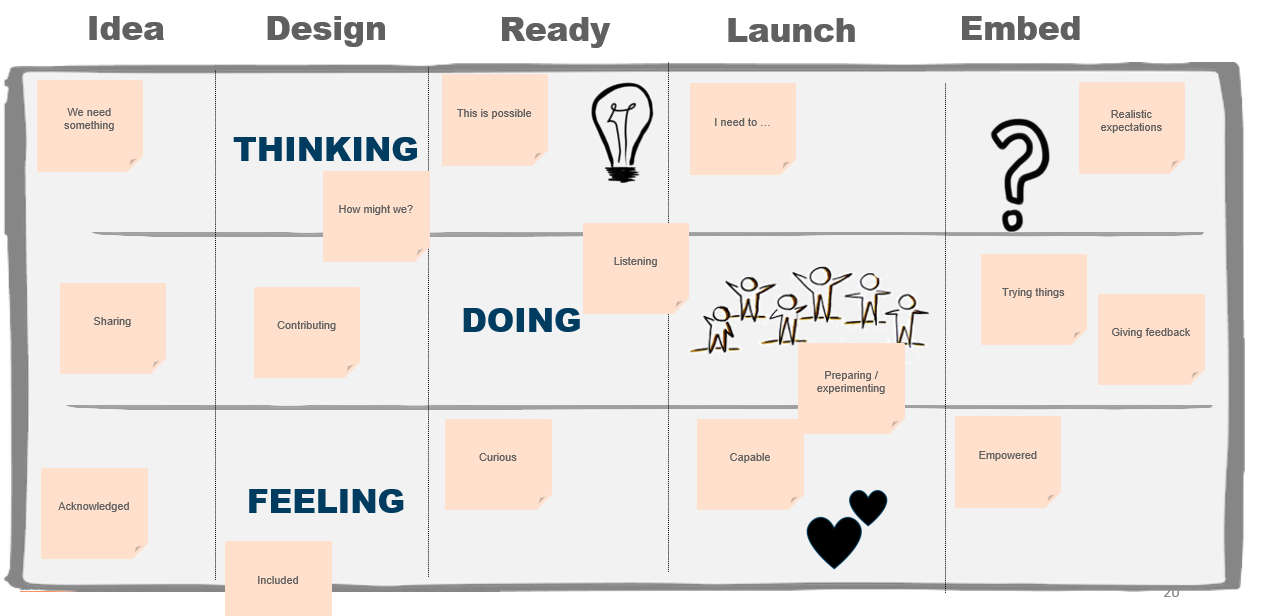Wait what? There’s a field of ChX?
Not yet, but we’re predicting there will be very soon, and definitely should be…
I’ve worked in change management for decades, and over the last few years moved into customer experience and workforce experience spaces. What I’ve discovered is that understanding ‘experience’ is the key to delivering successful change because it provides a more humanistic and integrated view of what’s happening. This taps into what Lena Ross has written about with design thinking and change and what Dr Jen Frahm identified just over a year ago.It’s worth looking at the history of the “experience” (X) movement.
Origins
UX: In 1993 Don Norman coined the term “user experience” for his group at Apple Computer[1].
CX: Lewis “Lou” Carbone is credited as the man who first used the term “customer experience” and is widely regarded as the father of the experience movement. His 1994 Marketing Management magazine article titled “Engineering Customer Experiences” is seen as the beginning of the customer experience discipline. [2]
EX: In 2016 Jacob Morgan, best-selling author and futurist describes EX as the combination of the cultural, physical, and technological environment of the workplace in a Forbes publication.[3]
ChX: In 2022 Dr Jen Frahm started talking about the Change Experience in one of her blog posts as a way of understanding a business strategy that integrates employee experience, customer experience, user experience and multi-experience across multiple touchpoints to adopt change.
How does it differ from change management?
Change management looks at the introduction of change from the lens of the initiator (whether that be change leader or change manager).
ChX takes a uniquely human centred design approach to understand the introduction of change from the recipient perspective. It’s an approach that puts humans at the heart of the change and considers the change from an external lens (the customers), the employee experience (all of organisation factors), the user experience (how easy is it to adopt the change).
It relies on design thinking and behavioural change approaches to understand what the recipients of change want the Change Experience to be.
Designing the ChX
Like UX, CX, and EX, the ChX can (and should) be deliberately designed.
It involves three key elements:
Determine who is part of your ChX – both directly and indirectly
The first step in any experience design is understanding who is part of the experience is. This is about putting the humans at the heart of the change.
Traditionally, we might have considered this in our change impact assessment; but generally, the impact assessment considers ‘what’ is changing, but doesn’t consider ‘how’ people will need to change. CX and UX do this by considering the ‘journey’; understanding the needs, wants and desires of customer or user; understanding the pain points; and designing products or services that address these elements.
When designing the ChX, talk with those who are impacted, understand how the change will impact what they do, think, and feel.
For example:
In designing the change experience you can use one of the Design Thinking tools – Think, Act, Feel. When going through change from the perspective of your employees, customers, suppliers, vendors, partners etc – what do you want them to think? How should they feel? What should they be doing?

Develop the ChX with each stakeholder.
Once you understand your stakeholders, you can then work with them to develop the ChX that meets their needs.
Some stakeholders may prefer a ‘light touch’ and only want to get involved at key points; for others, they may want to be involved in a range of change activities. ChX shifts the weight of driving the change from the leader to the stakeholder, and further encourages the shift of the role of the change manager away from the ‘managing’ to ‘co-creating’.

To develop the ChX, consider the following prompts:
- What do we already know about our stakeholders and the experience they may want? For this, tap into existing data, e.g., customer feedback, employee engagement data etc.
- How can we test elements of the change with a confined set of stakeholders? Consider how you can prototype the change or conduct a pilot.
- What support do they need during and after the change process? Ask your stakeholders what they need to be ready for the change.
- Imagine the change has been successful, what are people saying? Get your stakeholders to imagine the future – what’s different and how do they feel?
Importantly, the ChX may require a careful balancing of the experience across the stakeholders. It’s likely that the change may positively affect some stakeholders and negatively affect others, so the goal of the ChX is to consider this and how to keep the overall experience positive.
Test how the ChX is tracking
Of course, measuring the change experience is critical to ensuring it is the right change experience. We are big advocates for “measure as you go” – if you measure change in progress you have opportunities to course correct as necessary – it’s data informed decision making. The problem with most change projects is they measure at the point of installation or benefits realisation and it’s too late at that point. But that’s more for another day. The easiest way is to take the indicators you have identified in your ‘Think, Act, Feel” and determine how you would measure that easily and quickly.
ChX – beyond change management
ChX is a shift away from attempting to ‘manage’ change toward working with stakeholders to design and implement the change in a way that considers their needs, wants, and desires.
It is the consideration of the experience of all stakeholders in the change process and recognizes that designing a positive ChX requires careful balancing of needs across stakeholders.
Consider when you’ve had a positive ChX – what’s worked for you?
[1] https://www.nngroup.com/articles/100-years-ux/
[2] https://technode.global/2022/01/25/the-evolution-of-the-customer-experience/
[3] https://www.forbes.com/sites/jacobmorgan/2016/02/25/the-employee-experience-equation/


































